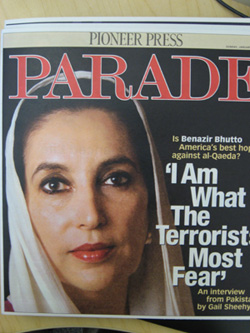 The filler material in the Sunday paper — comics, coupons, etc. — are printed days and, in some cases, weeks in advance.
The filler material in the Sunday paper — comics, coupons, etc. — are printed days and, in some cases, weeks in advance.
So perhaps it’s not surprising that the Parade magazine cover story on Benazir Bhutto (“I Am What The Terrorists Most Fear”) didn’t mention that she was killed last month.
The Pioneer Press didn’t run an editor’s note about the discrepancy, like those “today’s advertisement for GigondaMart incorrectly listed the hobby horse price. The actual price is $9.95. GigondaMart regrets the inconvenience” announcements.
For that, Pioneer Press editorial boss Thom Fladung accepts full responsibility. “It’s not an excuse, but Parade sent me an e-mail on January 2nd, and I was in Ohio on January 2nd. It’s always a mistake when you don’t communicate well with readers.”
The mistake may have been a topic at the journalistic water cooler, but it’s unlikely that folks read the Parade interview on Sunday, only to be shocked to find out on Monday that she’s dead.
The online version of the magazine contains the missing detail
Randy Siegel, the editor of Parade, said the insert was printed before Christmas and the only other option was not to distribute it at all. “We decided that this was an important interview to share with the American people,” he told the Associated Press.
At the Rapid City (SD) Journal, editor Mikel Lefort told readers, “After a brief e-mail exchange, the Journal decided we would include Parade in Sunday’s paper — but with an A1 explanation detailing the publication’s print schedule as well as our decision. Ultimately, we think that the interview — which includes Bhutto acknowledging that both the terrorists and the Pakistan government were targeting her — is compelling journalism and now a historical profile.”
But one reader wasn’t buying it, posting on the newspaper’s blog…
The fact that it would have cost the Tribune “millions of dollars” (according to its Public Editor) to amend or replace this article TEN FULL DAYS after Bhutto’s assasination gives a hint of just how obsolete the print media has become.
The Editor’s note on page 2 of the newspaper was only more troubling than the ludicrous gaff of running the story (unedited) in the first place.
The absurdity of not being able to pull a story that was tragically obsolete a week and a half before it ran eloquently answers the question, “Why has Internet news outpaced the print media?” But according to this logic, television–or radio news before it–should have put newspapers out of business half a century ago. So part of the problem newspapers face may not be in the competition posed by the Internet, but in the increasingly prefab nature of the medium.
Surely the behemoth of the Tribune has got to become more agile if it is to serve as anything more than a bit of irrelevant entertainment adhering to its raison d’être: advertising.
